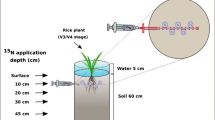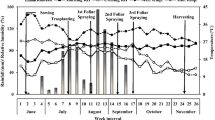Abstract
Background and aims
Knowledge on periodic uptake, accumulation and allocation of nitrogen (N), phosphorus (P) and potassium (K) in different tissues of a rice plant under different soil moisture management conditions is important when implementing efficient and effective water management practices ensuring sustainable rice production.
Methods
Rice variety Bg358 was grown in soil columns containing sufficient amounts of N, P and K. Four water management treatments were used; (i) continuous flooding (CF) of soil from crop establishment to maturity, (ii) CF until tillering (4 weeks) and Alternative Wetting and Drying (AWD4) thereafter, (iii) CF until flowering (10 weeks) and AWD thereafter (AWD10), (iv) CF until flowering and Top Soil Drying (TSD) thereafter (TSD10). Harvests were made in 2 weeks intervals.
Key results
Root growth of AWD4 decreased from 4th week compared with CF, and then enhanced from flowering onwards; thereby developing more roots in the top 20 cm soil layer increasing the root mass ratio. Both N and K uptake continued until maturity while P uptake continued until 2 weeks before maturity, and the amount taken up was highest for K and lowest for P. Moisture limitations substantially reduced tissue P content and retranslocation of P to panicles while the lowest reductions were observed in N. Therefore, internal utilisation was most efficient for P and lowest for N i.e., during grain filling N resorbed only from flag leaves, K from green, dead and flag leaves and only in AWD4, and P from green, flag and dead leaves, and stems.
Conclusion
Initially reduced root growth under AWD stimulated after flowering. Soil moisture limitation reduced P uptake greatly and thus had most efficient internal P utilisation mechanisms throughout the life cycle while those of N were the lowest.








Similar content being viewed by others
References
AgStat (2013) Socio economics and planning centre. Department of Agriculture, Sri Lanka
Ainsworth EA (2008) Rice production in a changing climate: a meta-analysis of responses to elevated carbon dioxide and elevated ozone concentration. Glob Chang Biol 14:1642–1650
Baethgen WE, Alley MM (1989) Optimizing soil and fertilizer nitrogen use by intensively managed winter wheat. I. Crop nitrogen uptake. Agron J 81:116–120
Baligar VC, Fageria NK, He ZL (2001) Nutrient use efficiency in plants. Commun Soil Sci Plant Anal 32:921–950
Bouman BAM (2001) Water-efficient management strategies in rice production. International rice research notes 16.2. International Rice Research Institute (IRRI), Los Baños, Philippines, pp 17–22
Bouman BAM, Tuong TP (2001) Field water management to save water and increase its productivity in irrigated rice. Agric Water Manag 49:11–30
Bouman BAM, Feng L, Tuong TP, Lu G, Wang H, Feng Y (2007) Exploring options to grow rice under water-short conditions in Northern China using a modelling approach. II: quantifying yield, water balance components, and water productivity. Agric Water Manag 88:23–33
Buresh RJ, Haefele SM (2010) Changes in paddy soils under transition to water-saving and diversified cropping system. In: Soil solution or a changing world: 19th world congress of soil science, IUSS, Brisbane, 1–6 Aug, pp 9–12
Buresh RJ, Pampolino MF, Witt C (2010) Field-specific potassium and phosphorus balances and fertilizer requirements for irrigated rice-based cropping systems. Plant Soil 335:35–64
Cao HX, Zhang ZB, Xu P, Chu LY, Shao HB, Lu ZH, Liu JH (2007) Mutual physiological genetic mechanism of plant high water use efficiency and nutrition use efficiency. Colloids Surf B: Biointerfaces 57:1–7
Cassman KG, Peng S, Olk DC, Ladha JK, Reichardt W, Dobenmann A, Singh U (1998) Opportunities for increased nitrogen-use efficiency from improved resource management in irrigated rice systems. Field Crop Res 56:7–39
Dobermann A, Cassman KG, Mamaril CP, Sheehy JE (1998) Management of phosphorus, potassium, and sulfur in intensive, irrigated lowland rice. Field Crop Res 56:113–138
FAO (2000) Fertilizer requirements in 2015 and 2030. Rome: food and agriculture organization of the United Nations. FAO, Rome, pp 18
Fixen PE (2009) World fertilizer nutrient reserves-a view to the future. Better Crops 93:8–11
García AG, Neto DD, Basanta MV, Ovejero RFL, Favarin JL (2003) Logistic rice model for dry matter and nutrient uptake. Sci Agric 60:481–488
Gaydon DS, Meinke H, Rodriguez D, McGrath DJ (2012) Comparing water options for irrigation farmers using modern portfolio theory. Agric Water Manag 115:1–9
Haefele SM, Wopereis MCS, Ndiaye MK, Barro SE, Isselmou MO (2003) Internal nutrient efficiencies, fertilizer recovery rates and indigenous nutrient supply of irrigated lowland rice in Sahelian West Africa. Field Crop Res 80:19–32
Huguenin-Elie O, Kirk GJD, Frossard E (2003) Phosphorus uptake by rice from soil that is flooded, drained or flooded then drained. Eur J Soil Sci 54:77–90
Inthapanya P, Sipaseuth SP, Sihathep V, Chanphengsay M, Fukai S, Basnayake J (2000) Genotype differences in nutrient uptake and utilisation for grain yield production of rainfed lowland rice under fertilized and non-fertilized conditions. Field Crop Res 65:57–68
Ju XT, Xing GX, Chen XP, Zhang SL, Zhang LJ, Liu XJ, Cui ZL, Yin B, Christie P, Zhu ZL, Zhang FS (2009) Reducing environmental risk by improving N management in intensive Chinese agricultural systems. Proc Natl Acad Sci U S A 106:3041–3046
Kano M, Inukai Y, Kitano H, Yamauchi A (2011) Root plasticity as the key root trait for adaptation to various intensities of drought stress water stresses in rice. Plant Soil 342:117–128
Kitson RE, Melon MG (1944) Colorimetric determination of phosphorus as molybdovanadophosphoric acid. Ind Eng Chem 16:379, Analytical Edition
Lambers H, Chapin FS, Pons TL (2008) Plant physiological ecology. Springer, New York, NY, USA
Li Y, Šimůnek J, Jing LF, Zhang ZT, Ni LX (2014) Evaluation of water movement and water losses in a direct-seeded rice field experiment using hydrus-1D. Agric Water Manag 142:38–46
Linquist BA, Phengsouvanna V, Sengxue P (2007) Benefits of organic residues and chemical fertilizer to productivity of rain-fed lowland rice and to soil nutrient balances. Nutr Cycl Agroecosyst 79:59–72
Liu M, Lin S, Dannenmann M, Tao Y, Saiz G, Zuo Q, Sippel S, Wei J, Cao J, Cai X, Butterbach-Bahl K (2013) Do water-saving ground cover rice production systems increase grain yields at regional scales? Field Crop Res 150:19–28
Malik RK, Yadav A (2008) Direct-seeded rice in the indo-gangetic plain: progress, problems and opportunities. In: Humphreys E, Roth CH (eds) Permanent beds and rice-residue management for rice–wheat systems in the indo-gangetic plain. Proceedings of a workshop held in Ludhiana, India, 7–9 September 2006. ACIAR, Canberra, pp 133–143, ACIAR Proceedings No. 127
Naklang K, Harnpichitvitaya D, Amarante ST, Wade LJ, Haefele SM (2006) Internal efficiency, nutrient uptake, and the relation to field water resources in rain fed lowland rice of northeast Thailand. Plant Soil 286:193–208
Nelson DW, Sommers LE (1980) Determination of total nitrogen in plant material. Agron J 65:109–112
Olsen SR, Cole CV, Watanable FS, Dean LA (1954) Estimation of available phosphorus in soils by extraction with sodium bicarbonate. USDA circular No. 939. U.S. Government Printing Office, Washington DC
O’Toole JC, Padilla JL (1984) Water deficits and nitrogen uptake as affected by water table depth in rice (Oryza sativa L.). Plant Soil 80:127–132
SAS Institute (1995) SAS/Stat user guide, vol 2, version 6.1. SAS Institute, Carry
Shimono H (2011) Earlier rice phenology as a result of climate change can increase the risk of cold damage during reproductive growth in northern Japan. Agric Ecosyst Environ 144:201–207
Shimono H, Bunce JA (2009) Acclimation of nitrogen uptake capacity of rice to elevated atmospheric CO2 concentration. Ann Bot 103:87–94
Suriyagoda L, De Costa WAJM, Lambers H (2014a) Growth and phosphorus nutrition of rice when inorganic fertiliser application is partly replaced by straw under varying moisture availability in sandy and clay soils. Plant Soil 384:53–68
Suriyagoda LDB, Ryan MH, Renton M, Lambers H (2014b) Plant responses to limited moisture and phosphorus availability – a meta-analysis. Adv Agron 124:133–200
Tuong TP, Bouman BAM (2002) Rice production in water-scarce environments. Proceedings of the water productivity workshop, 12–14 November 2001. International Water Management Institute (IWMI), Sri Lanka
Van Ranst E, Verloo M, Demeyer A, Pauwels JM (1999) Manual for the soil chemistry and fertility laboratory-analytical methods for soils and plants, equipment, and management of consumables. University of Gent, Gent, Belgium
Walkley A, Black IA (1934) An examination of the Degtjareff method for determining organic carbon in soils: effect of variations in digestion conditions and of inorganic soil constituents. Soil Sci 63:251–263
Weerarathne LVY, Suriyagoda LDB, Marambe B (2015) Competitive effects of barnyard grass (echinochloa crus-galli L. Beauv) on rice (Oryza sativa L.) is less when phosphorus is applied to deeper layers of a phosphorus-deficient soil irrespective of the soil moisture availability. Plant Soil. doi:10.1007/s11104-015-2383-y
Witt C, Dobermann A, Abdulrachman S, Gines HC, Guanghuo W, Nagarajan R, Satawathananont S, Son TT, Tan PS, Tiem LV, Simbahan G, Olk DC (1999) Internal nutrient efficiencies in irrigated lowland rice of tropical and subtropical Asia. Field Crop Res 63:113–138
Ye Y, Liang X, Chen Y, Li L, Ji Y, Zhu C (2014) Carbon, nitrogen and phosphorus accumulation and partitioning, and C:N:P stoichiometry in late-season rice under different water and nitrogen managements. PLoS ONE 9(7):e101776. doi:10.1371/journal.pone.0101776
Acknowledgments
The authors appreciate the financial support from the National Research Council, Sri Lanka under the grant NRC-11-179, and technical assistance provided by G. Wijesuriya. Authors appreciate the critical comments given by Dr LW Galagedara, Memorial University of Newfoundland, Canada and two reviewers to an earlier version of this manuscript.
Author information
Authors and Affiliations
Corresponding author
Additional information
Responsible Editor: Tim S. George.
Electronic supplementary material
Below is the link to the electronic supplementary material.
Table S1
Significance of different sources of variability (DOC 83 kb)
Fig. S1
Nitrogen (N) (a and b), phosphorus (P) (c and d) and potassium (K) (e and f) contents in different shoot components of rice plants from flowering (10th week) to maturity (16th week) when exposed to either Continuous Flooding (CF), Alternate Wetting and Drying from 4th or 10th week (AWD4 and AWD10, respectively), or Top Soil Drying from 10th week (TSD10) Note: the difference in Y-axis scale, (mean values ± se, n = 4) Note: the difference in Y-axis scales (DOC 325 kb)
Rights and permissions
About this article
Cite this article
Somaweera, K.A.T.N., Suriyagoda, L.D.B., Sirisena, D.N. et al. Accumulation and partitioning of biomass, nitrogen, phosphorus and potassium among different tissues during the life cycle of rice grown under different water management regimes. Plant Soil 401, 169–183 (2016). https://doi.org/10.1007/s11104-015-2541-2
Received:
Accepted:
Published:
Issue Date:
DOI: https://doi.org/10.1007/s11104-015-2541-2




